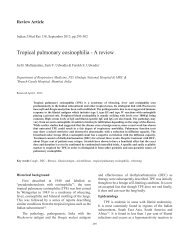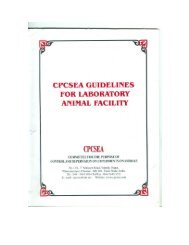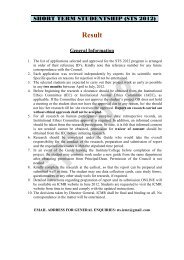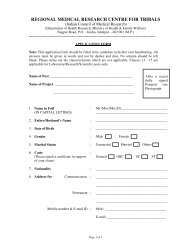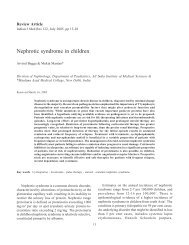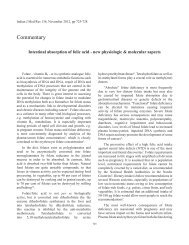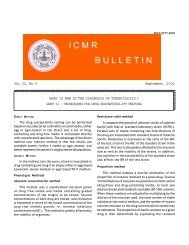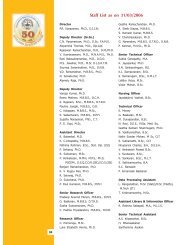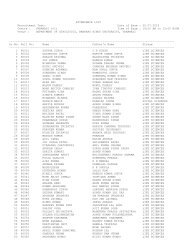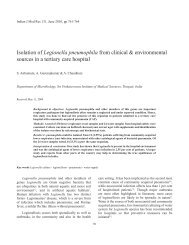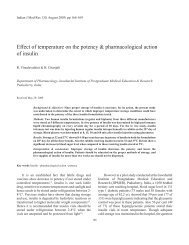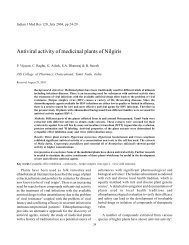High risk behaviours & alcohol dependence - Indian Council of ...
High risk behaviours & alcohol dependence - Indian Council of ...
High risk behaviours & alcohol dependence - Indian Council of ...
Create successful ePaper yourself
Turn your PDF publications into a flip-book with our unique Google optimized e-Paper software.
<strong>Indian</strong> J Med Res 129, April 2009, pp 354-356<br />
Commentary<br />
<strong>High</strong> <strong>risk</strong> <strong>behaviours</strong> & <strong>alcohol</strong> <strong>dependence</strong><br />
In this issue, Poulose et al 1 report high-<strong>risk</strong><br />
behaviour following <strong>alcohol</strong> use in patients admitted<br />
for treatment <strong>of</strong> <strong>alcohol</strong> <strong>dependence</strong>. The authors<br />
approached patients admitted for <strong>alcohol</strong> <strong>dependence</strong><br />
syndrome and used the event analysis technique<br />
which involves inquiring about occurrence <strong>of</strong> high<br />
<strong>risk</strong> behaviour in temporal association with significant<br />
<strong>alcohol</strong> use as defined for the purpose <strong>of</strong> the study<br />
from patients and corroborated by their relatives. <strong>High</strong><br />
<strong>risk</strong> behaviour has been defined as an occurrence <strong>of</strong><br />
event with probability <strong>of</strong> harm and bearing a temporal<br />
relationship to consumption <strong>of</strong> <strong>alcohol</strong>. The authors<br />
have also tried to differentiate those with high <strong>risk</strong><br />
<strong>behaviours</strong> from those without on measures <strong>of</strong> severity<br />
<strong>of</strong> addiction, sensation seeking and impulsivity.<br />
Methodologically, it is important to appreciate that<br />
this study used a hospital-based, purposive sample<br />
without a control group and thus cannot be termed as<br />
ideal. The study also used an event analysis method<br />
based on a questionnaire developed by the authors that<br />
has not been validated elsewhere and the instruments<br />
used were local language translations <strong>of</strong> the sensation<br />
seeking scale 2 and the Barratt’s impulsiveness scale 3 .<br />
Notwithstanding the methodological problems<br />
which have probably arisen due to logistical<br />
constraints, this study raises some important issues.<br />
The first deals with the consequences <strong>of</strong> <strong>alcohol</strong> use<br />
and the second, the role that personality factors <strong>of</strong><br />
<strong>alcohol</strong> abusers and the bearing these factors have on<br />
issues such as the antecedents <strong>of</strong> <strong>alcohol</strong> <strong>dependence</strong><br />
and the determinants <strong>of</strong> the varying outcomes in<br />
patients with <strong>alcohol</strong> <strong>dependence</strong>.<br />
Alcohol use is one <strong>of</strong> the leading causes <strong>of</strong><br />
morbidity and mortality 4 . The indirect consequences<br />
<strong>of</strong> <strong>alcohol</strong> abuse such as disruption in family life,<br />
employment and productivity are even more pr<strong>of</strong>ound.<br />
A major determinant <strong>of</strong> these consequences is the<br />
354<br />
proclivity <strong>of</strong> persons with <strong>alcohol</strong> <strong>dependence</strong> to<br />
indulge in reckless behaviour which may put them<br />
and others at the <strong>risk</strong> <strong>of</strong> harm. The authors have used<br />
the event analysis method to find out the temporal<br />
association between <strong>alcohol</strong> use <strong>of</strong> a defined magnitude<br />
and subsequent road traffic accidents, violent acts, selfinjurious<br />
behaviour and unprotected sexual intercourse<br />
with commercial sex worker or with partner other than<br />
the marital partner. While the authors have been able<br />
to find that 64.3 per cent <strong>of</strong> the patient cohort had in<br />
fact indulged in such <strong>behaviours</strong>, it may be argued that<br />
this is an expected finding given that this behaviour<br />
occurred within 2 h <strong>of</strong> consumption over a period <strong>of</strong><br />
not more than 2 h <strong>of</strong> 32 ml <strong>of</strong> <strong>alcohol</strong>. The responses<br />
to the questions may have been affected by issues <strong>of</strong><br />
recall bias, the answers provided by relatives may have<br />
been exaggerated or attenuated regarding the nature <strong>of</strong><br />
<strong>alcohol</strong> abuse and the <strong>risk</strong>y behaviour and there was a<br />
lack <strong>of</strong> any objective measures <strong>of</strong> blood <strong>alcohol</strong> levels<br />
at the time <strong>of</strong> the event. Yet, the study does fill a gap in<br />
the literature describing high <strong>risk</strong> <strong>behaviours</strong> following<br />
<strong>alcohol</strong> use in patients with <strong>alcohol</strong> <strong>dependence</strong> in<br />
India. While the association <strong>of</strong> road traffic accidents<br />
with <strong>alcohol</strong> use is expected, it is significant that the<br />
other <strong>risk</strong>-taking <strong>behaviours</strong> such as sexual <strong>risk</strong>-taking<br />
behaviour and violence were also common. It is also<br />
obvious that many <strong>of</strong> the patients may have had more<br />
than one type <strong>of</strong> <strong>risk</strong>-taking behaviour and on multiple<br />
occasions. This brings into focus the repetitive nature<br />
<strong>of</strong> the use <strong>of</strong> substance despite the harm accrued due<br />
to such use. However, it must be stressed that the<br />
subjects in the study were inpatients and thus may only<br />
represent a cohort where the severity <strong>of</strong> <strong>alcohol</strong> abuse<br />
was enough to necessitate admission. Further, some<br />
<strong>of</strong> all the all-male cohort <strong>of</strong> patients may have been<br />
admitted for reasons related to high <strong>risk</strong> behaviour<br />
rather than <strong>alcohol</strong> <strong>dependence</strong> per se. Also, many <strong>of</strong><br />
those patients whose <strong>risk</strong>-taking <strong>behaviours</strong> involved
MATTOO & SINGH: HIGH RISK BEHAVIOURS & ALCOHOL DEPENDENCE 355<br />
serious injury or incarceration may never reach a deaddiction<br />
ward in a hospital.<br />
Another important issue is one <strong>of</strong> the intimate<br />
relationships between personality variables and<br />
substance abuse. The authors reported that patients<br />
with <strong>alcohol</strong> <strong>dependence</strong> and <strong>risk</strong>y behaviour had<br />
significantly higher scores on sensation seeking,<br />
impulsivity and addiction severity. <strong>High</strong> levels <strong>of</strong><br />
sensation seeking have earlier been reported in patients<br />
with opioid use disorders 2 . Further, there is a known<br />
association between personality disorders and substance<br />
abuse across age, sex and different cultures 5 . For<br />
instance, the National Comorbidity Survey found that<br />
the odds <strong>of</strong> developing <strong>alcohol</strong> or drug <strong>dependence</strong><br />
increased five-fold in the presence <strong>of</strong> conduct disorder<br />
without adult antisocial disorder and 10 to 14-fold if only<br />
adult antisocial personality disorder or both conduct and<br />
antisocial disorder were present 6 . A similar concept <strong>of</strong><br />
neurobehavioural disinhibition (derived from measures<br />
<strong>of</strong> affect, behaviour and cognition) has also been found<br />
to be predictive <strong>of</strong> future substance use disorders when<br />
measured in children 7 . It follows that personality<br />
variables <strong>of</strong> sensation seeking, impulsivity, conduct<br />
problems may antedate the initiation and development<br />
<strong>of</strong> substance abuse and <strong>dependence</strong>, respectively.<br />
It is increasingly being recognised that aetiology <strong>of</strong><br />
substance use disorders has a component <strong>of</strong> personality<br />
variables such as sensation seeking, impulsivity and<br />
adventurousness that may lead to an increased likelihood<br />
<strong>of</strong> initiation <strong>of</strong> drug use and may contribute to eventual<br />
<strong>dependence</strong> as well 8 . The reasons for this propensity are<br />
not well understood but may involve factors such as<br />
self-medication, increased curiosity and recklessness,<br />
and drug use as a way <strong>of</strong> coping with alienation from<br />
peers and pursuits as a consequence <strong>of</strong> these personality<br />
variables. Another area <strong>of</strong> research in substance use<br />
disorders has been the use <strong>of</strong> these behavioural patterns<br />
as endophenotypes or vulnerability factors that are<br />
found more <strong>of</strong>ten in the family <strong>of</strong> the probands than in<br />
the general population 9 . A consequence <strong>of</strong> this sort <strong>of</strong><br />
a conception is the supposition that what is inherited<br />
in substance use disorders is among others a set <strong>of</strong><br />
neuropsychological vulnerability factors that predispose<br />
an individual to the development <strong>of</strong> substance use<br />
disorders. This has been supported by the fact that<br />
patients with <strong>alcohol</strong> <strong>dependence</strong> are more likely to<br />
have a positive family history for <strong>alcohol</strong> use disorders,<br />
have a similar personality pr<strong>of</strong>ile and are more likely to<br />
be heavier drinkers 10 . In this study as well, the authors<br />
have found an increased frequency <strong>of</strong> <strong>alcohol</strong> use in the<br />
family members <strong>of</strong> patients with high <strong>risk</strong> behaviour<br />
compared to those without but this difference was not<br />
significant. This may be due to the methodological<br />
constraints alluded to earlier and requires further study.<br />
The fact that there was a significant difference in the<br />
addiction severity index and measures <strong>of</strong> sensation<br />
seeking and impulsivity between those who did and did<br />
not report high <strong>risk</strong> behaviour indicates the presence in<br />
this cohort <strong>of</strong> a construct similar to the type I and type<br />
II <strong>alcohol</strong>ism in men 8 . Type I <strong>alcohol</strong>ism is associated<br />
with a later onset, less severe and is more sensitive to<br />
environmental factors whereas type II <strong>alcohol</strong>ism is<br />
associated with an earlier onset, antisocial behaviour<br />
and a stronger genetic basis for increased vulnerability.<br />
While the authors have not enquired about age at onset<br />
<strong>of</strong> <strong>alcohol</strong> <strong>dependence</strong>, it indicates that the cohort <strong>of</strong><br />
patients stretched along a continuum with less severely<br />
dependent patients at one end who were characterised<br />
by fewer behavioural and inherited predisposing factors<br />
and more severely dependent patients characterized by<br />
more behavioural and inherited predisposing factors<br />
on the other end. Whereas attempts at the validation <strong>of</strong><br />
constructs such as that <strong>of</strong> type I and type II <strong>alcohol</strong>ism<br />
have been mixed 11 , there is no doubt that personality<br />
factors do play an important role in substance abuse<br />
disorders in general, and <strong>alcohol</strong> abuse disorders, in<br />
particular. This paper represents a much needed research<br />
attempt into this area <strong>of</strong> study.<br />
S.K. Mattoo * & S.M. Singh<br />
Drug De-addiction & Treatment Centre<br />
Department <strong>of</strong> Psychiatry, Postgraduate Institute <strong>of</strong><br />
Medical Education & Research, Chandigarh 160 012<br />
& Gian Sagar Medical College, Banur, Punjab, India<br />
*<br />
For correspondence:<br />
skm_ddtc@glide.net.in<br />
References<br />
1. Biju Poulose, Krishnamachari Srinivasan. <strong>High</strong> <strong>risk</strong><br />
<strong>behaviours</strong> following <strong>alcohol</strong> use in <strong>alcohol</strong> dependent men.<br />
<strong>Indian</strong> J Med Res 2009; 129 : 376-81.<br />
2. Basu D, Varma VK, Malhotra S, Malhotra A. Sensation<br />
seeking scale: <strong>Indian</strong> adaptation. <strong>Indian</strong> J Psychiatry 1993;<br />
35 : 155-8.<br />
3. Patton JH, Stanford MS, Barratt ES. Factor structure <strong>of</strong> the<br />
Barratt impulsiveness scale. J Clin Psychol 1995; 51 : 768-74.<br />
4. Mäkelä P. Alcohol-related mortality by age and sex and its<br />
impact on life expectancy: estimates based on the Finnish<br />
death register. Eur J Public Health 1998; 8 : 43-51.<br />
5. Regier DA, Farmer ME, Rae DS, Locke BZ, Keith SJ, Judd<br />
LL et al. Comorbidity <strong>of</strong> mental disorders with <strong>alcohol</strong> and<br />
other drug abuse. Results from the Epidemiologic catchment<br />
area (ECA) study. JAMA 1990; 264 : 2511-8.
356 INDIAN J MED RES, APRIL 2009<br />
6. Anthony JC, Warner LA, Kessler RC. Comparative<br />
epidemiology <strong>of</strong> <strong>dependence</strong> on tobacco, <strong>alcohol</strong>, controlled<br />
substances and inhalants: basic findings from the National<br />
Comorbidity Survey. Exp Clin Psychopharmacol 1994; 2 :<br />
244-68.<br />
7. Tarter RE, Kirisci L, Mezzich A, Cornelius JR, Pajer K,<br />
Vanyukov M, et al. Neurobehavioral disinhibition in childhood<br />
predicts early age at onset <strong>of</strong> substance use disorder. Am J<br />
Psychiatry 2003; 160 : 1078-85.<br />
8. Institute <strong>of</strong> Medicine. Pathways <strong>of</strong> addiction: opportunities<br />
in drug abuse research. Washington, DC: National Academy<br />
Press, 1996.<br />
9. Gottesman I, Gould TD. The endophenotype concept<br />
in psychiatry: etymology and strategic intentions. Am J<br />
Psychiatry 2003; 160 : 636-45.<br />
10. Bierut LJ, Dinwiddie SH, Begleiter H, Crowe RR,<br />
Hesselbrock V, Nurnberger JI Jr, et al. Familial transmission<br />
<strong>of</strong> substance <strong>dependence</strong>: <strong>alcohol</strong>, marijuana, cocaine and<br />
habitual smoking: a report from the Collaborative Study on<br />
the Genetics <strong>of</strong> Alcoholism. Arch Gen Psychiatry 1998; 55 :<br />
982-8.<br />
11. Babor TF, Caetano R. Subtypes <strong>of</strong> substance <strong>dependence</strong> and<br />
abuse: implications for diagnostic classification and empirical<br />
research. Addiction 2006; 101 : (Suppl 1): 104-10.



